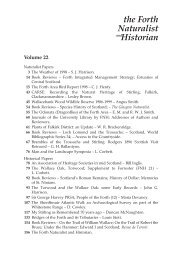fnh journal vol 24 - Forth Naturalist and Historian - University of Stirling
fnh journal vol 24 - Forth Naturalist and Historian - University of Stirling
fnh journal vol 24 - Forth Naturalist and Historian - University of Stirling
You also want an ePaper? Increase the reach of your titles
YUMPU automatically turns print PDFs into web optimized ePapers that Google loves.
26 C.J. Henty<br />
Thanks are due to S.J. Harrison for a copy <strong>of</strong> the Annual Climatological<br />
Bulletin (2000), to J. Mitchell for a copy <strong>of</strong> the L.Lomond report, to P. <strong>Stirling</strong>-<br />
Aird for data from the Raptor Study Group, <strong>and</strong> to D.M. Bryant for the results<br />
<strong>of</strong> the estuary WEBS data.<br />
It is with great sadness that I am unable to add the name <strong>of</strong> Bill<br />
Brackenridge to those that have assisted in compiling this report. Most readers<br />
will know that he was killed in a traffic accident in November (2000), whilst<br />
returning from the SOC annual conference. For many years he produced a<br />
wealth <strong>of</strong> field observations <strong>and</strong> helped, as Assistant Recorder, with assessing<br />
records <strong>and</strong> pro<strong>of</strong> reading the draft reports, more recently he wrote a section<br />
<strong>of</strong> the species accounts. His exceptionally wide knowledge <strong>of</strong> natural history<br />
showed both in his work in conservation planning <strong>and</strong> in his consistent efforts<br />
in giving talks, leading field trips, <strong>and</strong> always being ready to help people with<br />
their queries. A full obituary appeared in the June issue <strong>of</strong> Scottish Birds (Vol<br />
22, No 1).<br />
RESULTS OF THE BBS SURVEYS FOR CENTRAL REGION<br />
(Based on a comprehensive summary by NB)<br />
This year the bird report continues to make extensive use in the species<br />
accounts <strong>of</strong> results from the Breeding Birds Survey, these are in terms <strong>of</strong> the<br />
frequency <strong>of</strong> occurence <strong>of</strong> a species along linear transects in several habitat<br />
types. In 2000, 29 1x1 kilometre squares were surveyed, one less than 1999.<br />
Each square is usually visited twice in spring/summer, a total <strong>of</strong> 2 km on a set<br />
route is walked per visit <strong>and</strong> all birds noted in 200 m sections; a st<strong>and</strong>ardised<br />
habitat survey is done on another visit. In the main report I have presented<br />
selected results, calculated as birds per 10 km <strong>of</strong> habitat, for the major habitats<br />
where it is likely that the birds are breeding locally. For species that are scarce<br />
– say, one or less per 10 km – results may vary erratically from year to year.<br />
Each square (sometimes half squares) <strong>and</strong> the birds noted in it have been<br />
attributed to one <strong>of</strong> four major habitats – Mountain <strong>and</strong> moorl<strong>and</strong> (=moor),<br />
Conifers (woodl<strong>and</strong> + wood/moorl<strong>and</strong> edge), Farml<strong>and</strong>, Urban/suburban.<br />
Broadleaved woodl<strong>and</strong> occurs mainly as copses in farml<strong>and</strong> whilst conifer<br />
woodl<strong>and</strong> includes both young plantations <strong>and</strong> mature woods, thus “Conifers”<br />
figures may include species <strong>of</strong> scrub <strong>and</strong> moorl<strong>and</strong> edge which are not found<br />
in mature plantations. Also, some urban squares may include bushy areas on<br />
the fringe <strong>of</strong> towns.<br />
An average <strong>of</strong> 25 species were recorded per square (excluding four squares<br />
that were visited only once <strong>and</strong> one with numbers <strong>of</strong> non-breeding gulls <strong>and</strong><br />
waders), but with great variation from five on high moorl<strong>and</strong> to 35 on mixed<br />
farml<strong>and</strong>, numbers <strong>of</strong> individuals also varied widely from 59 to 620, average<br />
318. The commonest species per habitat were: Moor – Meadow Pipit, Conifer –<br />
Chaffinch, Farml<strong>and</strong> – Starling, Urban – Starling. Species showing marked<br />
increases (40 % or greater) included Lapwing, Oystercatcher, Skylark,<br />
Whitethroat, Sedge Warbler, Starling <strong>and</strong> Goldfinch. Whinchat, Jay, Bullfinch<br />
<strong>and</strong> Siskin are now well below their long term means.



